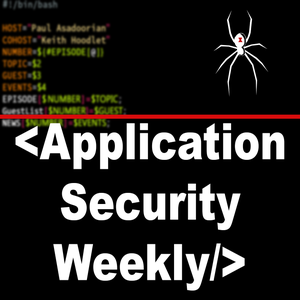
Application Security Weekly (Video)
Security Weekly
ASW
- 34 minutes 47 secondsNew SLAP & FLOP Attacks, OCSP Fades Away, DeepSeek's ClickHouse, OAuth 2.0 Security - ASW #316
Speculative data flow attacks demonstrated against Apple chips with SLAP and FLOP, the design and implementation choices that led to OCSP's demise, an appsec angle on AI, updating the threat model and recommendations for implementing OAuth 2.0, and more!
Show Notes: https://securityweekly.com/asw-316
4 February 2025, 5:00 pm - 36 minutes 54 secondsThreat Modeling That Helps the Business - Sandy Carielli, Akira Brand - ASW #316
Threat modeling has been in the appsec toolbox for decades. But it hasn't always been used and it hasn't always been useful. Sandy Carielli shares what she's learned from talking to orgs about what's been successful, and what's failed, when they've approached this practice. Akira Brand joins to talk about her direct experience with building threat models with developers.
Show Notes: https://securityweekly.com/asw-316
4 February 2025, 10:00 am - 34 minutes 57 secondsOpengrep & Semgrep, Hacking Subarus, Hacking Synths, Stealing Cookies, and RANsacked - ASW #315
An open source security project forks in response to license changes (and an echo of how we've been here before), car hacking via spectacularly insecure web apps, hacking a synth via spectacularly cool MIDI messages, cookie parsing problems, the RANsacked paper of 100+ LTE/5G vulns found from fuzzing, and more!
Show Notes: https://securityweekly.com/asw-315
28 January 2025, 5:00 pm - 33 minutes 38 secondsSecurity the AI SDLC - Niv Braun - ASW #315
A lot of AI security boils down to the boring, but important, software security topics that appsec teams have been dealing with for decades. Niv Braun explains the distinctions between AI-related and AI-specific security as we avoid the FUD and hype of genAI to figure out where appsec teams can invest their time. He notes that data scientists have been working with ML and sensitive data sets for a long time, and it's good to have more scrutiny on what controls should be present to protect that data.
This segment is sponsored by Noma Security. Visit https://securityweekly.com/noma to learn more about them!
Show Notes: https://securityweekly.com/asw-315
28 January 2025, 10:00 am - 52 minutes 10 secondsAppsec Predictions for 2025 - Cody Scott - ASW #314
What’s in store for appsec in 2025? Sure, there'll be some XSS and SQL injection, but what about trends that might influence how appsec teams plan? Cody Scott shares five cybersecurity and privacy predictions and we take a deep dive into three of them. We talk about finding value to appsec from AI, why IoT and OT need both programmatic and technical changes, and what the implications of the next XZ Utils attack might be.
Segment resources:
Show Notes: https://securityweekly.com/asw-314
21 January 2025, 10:00 am - 31 minutes 43 secondsPyPI's Quarantine, Phishing & Awareness, Porting Fishshell to Rust, Cyber Trust Mark - ASW #313
Design lessons from PyPI's Quarantine capability, effective ways for appsec to approach phishing, why fishshell is moving to Rust component by component (and why that's a good thing!), what behaviors the Cyber Trust Mark might influence, and more!
Show Notes: https://securityweekly.com/asw-313
14 January 2025, 5:00 pm - 36 minutes 4 secondsDiscussing Useful Security Requirements with Developers - Ixchel Ruiz - ASW #313
There's a pernicious myth that developers don't care about security. In practice, they care about code quality. What developers don't care for is ambiguous requirements. Ixchel Ruiz shares her experience is discussing software designs, the challenges in prioritizing dev efforts, and how to help open source project maintainers with their issue backlog.
Segment resources:
Show Notes: https://securityweekly.com/asw-313
14 January 2025, 10:00 am - 33 minutes 24 secondsRemoving Rust, Double Clickjacking, h3i CLI, JWT Mistakes, Reviewing Recursion - ASW #312
Curl removes a Rust backend, double clickjacking revives an old vuln, a new tool for working with HTTP/3, a brief reminder to verify JWT signatures, design lessons from recursion, and more!
Show Notes: https://securityweekly.com/asw-312
7 January 2025, 5:00 pm - 33 minutes 48 secondsDefectDojo and Bringing Quality Appsec Tools to Small Appsec Teams - Greg Anderson - ASW #312
All appsec teams need quality tools and all developers benefit from appsec guidance that's focused on meaningful results. Greg Anderson shares his experience in bringing the OWASP DefectDojo project to life and maintaining its value for over a decade. He reminds us that there are tons of appsec teams with low budgets and few members that need tools to help them bring useful insights to developers.
Segment Resources:
- https://owasp.org/www-project-defectdojo/
- Three-quarters of CISOs surveyed reported being "overwhelmed" by the growing number of tools and their alerts: https://www.darkreading.com/cloud-security/cisos-throwing-cash-tools-detect-breaches
- As many as one-fifth of all cybersecurity alerts turn out to be false positives. Among 800 IT professionals surveyed, just under half of them stated that approximately 40% of the alerts they receive are false positives: https://www.securitymagazine.com/articles/97260-one-fifth-of-cybersecurity-alerts-are-false-positives
- 91% of organizations knowingly released vulnerable applications, 57% of vulnerabilities are left unresolved by developers, 32% of CISOs deploy vulnerable code in the hopes it won’t be discovered, 56% of developers struggle to prioritize vulnerability fixes: https://info.checkmarx.com/future-of-application-security-2024
Show Notes: https://securityweekly.com/asw-312
7 January 2025, 10:00 am - 35 minutes 35 secondsAncient Curl Bug, AWS re:Invent, Malware in NPM, Census III Report, MS OTP - ASW #311
Curl's oldest bug yet, RCPs (and more!) from AWS re:Invent, possible controls for NPM's malware proliferation, insights and next steps on protecting top 500 packages from the Census III report, the flawed design choice that made Microsoft's OTP (successfully) brute-forceable, and more!
00:00 - Intro & Cyber Resilience Insights 01:20 - The 25-Year-Old Curl Bug Story 04:17 - Fuzzing for Security: A Missed Opportunity? 08:46 - AWS re:Invent Security Highlights 11:54 - NPM Malware Surge 16:33 - Small Packages, Big Risks in NPM 19:55 - Open Source Security Trends 24:27 - Microsoft MFA Vulnerability Explained 28:28 - Hardware Hacking & DMA Exploits 30:55 - Auditing Ruby’s Package Ecosystem 34:02 - Looking Ahead to 2025
Show Notes: https://securityweekly.com/asw-311
16 December 2024, 10:00 pm - 34 minutes 9 secondsApplying Usability and Transparency to Security - Hannah Sutor - ASW #311
Practices around identity and managing credentials have improved greatly since the days of infosec mandating 90-day password rotations. But those improvements didn't arise from a narrow security view. Hannah Sutor talks about the importance of balancing security with usability, the importance of engaging with users when determining defaults, and setting an example for transparency in security disclosures.
Segment resources
00:00 Welcome to Application Security Weekly! 01:49 Meet the Experts 03:28 What Are Non-Human Identities? 06:17 Balancing Security & Usability 08:24 MFA Challenges & Admin Security 12:09 Navigating Breaking Changes 16:05 Security by Design in Action 18:42 Identity Management for Startups 20:18 Secure by Design: Real Impact 24:03 Transparency After a Critical Vulnerability 31:39 Looking Ahead to 2025 32:45 Application Security in Three Words
Show Notes: https://securityweekly.com/asw-311
16 December 2024, 10:00 am - More Episodes? Get the App
Your feedback is valuable to us. Should you encounter any bugs, glitches, lack of functionality or other problems, please email us on [email protected] or join Moon.FM Telegram Group where you can talk directly to the dev team who are happy to answer any queries.
 CyberWire Daily
CyberWire Daily
 Smashing Security
Smashing Security
 Darknet Diaries
Darknet Diaries
 CYBER
CYBER
 Cloud Security Podcast by Google
Cloud Security Podcast by Google
 SANS Internet Stormcenter Daily Cyber Security Podcast (Stormcast)
SANS Internet Stormcenter Daily Cyber Security Podcast (Stormcast)